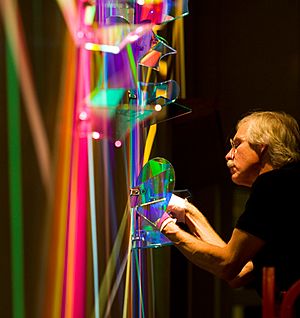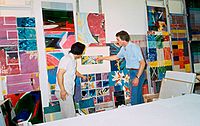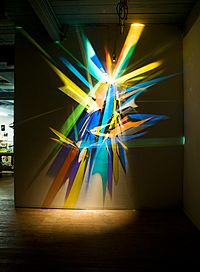Stephen Knapp facts for kids
Quick facts for kids
Stephen Knapp
|
|
|---|---|

Stephen Knapp assembling a lightpainting, 2006.
|
|
| Born | October 15, 1947 |
| Died | November 24, 2017 (aged 70) Worcester, Massachusetts, U.S.
|
| Nationality | American |
| Education | Hamilton College |
| Known for | Architectural installation, mixed-media sculpture, photography, and ceramics |
| Movement | Lightpainting |
Stephen Knapp (born October 15, 1947 – died November 24, 2017) was an American artist. He was famous for creating amazing art using light, a technique called lightpainting. Stephen was from Worcester, Massachusetts. His large artworks are now in museums, public places, companies, and private homes all over the world. He used many different materials like light, glass, metal, stone, and ceramics.
Knapp also wrote and gave talks about art made for buildings. He taught others how artists and architects can work together. His art was shown in many magazines and newspapers, like Art and Antiques and The New York Times.
Contents
Stephen Knapp's Early Life and Art Journey
Stephen Knapp finished school at Worcester Academy in 1965. He then earned his degree from Hamilton College in 1969. For almost ten years after college, he worked as a fine art photographer. He sold his photos to companies and people in the U.S. and other countries. During this time, Knapp worked with Polaroid Corporation. He helped them create large instant photographs using their special 20x24 camera.
Soon, photography felt like it wasn't enough for him. Knapp started looking at materials that would last a long time. His studio became full of different types of ceramic, mosaic, metal, stone, and glass. He began to develop new ways of combining these materials. He also worked with skilled craftspeople and factories from all over the world. This allowed him to create bigger and bigger artworks.
Exploring New Materials and Techniques
In 1985, Knapp traveled to Japan for his research. There, he made some of the world's largest ceramic murals using glass glaze. He found a factory that made huge photo-ceramic murals. This technique was used by artist Robert Rauschenberg in the early 1980s. Knapp became very interested in a thick, crackle glass glaze. This glaze was made for buildings. Changing surfaces to reflect light became a big idea in his later work.
The next year, he used photo-transfer methods to create images on aluminum. He then etched and colored the metal. This led to one of the world's largest etched-metal murals. It was 14 feet tall and 72 feet long. This huge artwork was made for the Hamilton County Justice Complex in Cincinnati.
Knapp often used what he learned from one project to help with the next. For example, he created two large etched stainless-steel murals for McDonnell Douglas in California. For these, he developed a new way to mix paints. This made the surface of the murals look different depending on how the light hit them. These murals seemed to move and have energy. If you looked closely, you could see his interest in making things look like they had depth. This idea would later become very important in his lightpaintings.
Focusing on Glass and Light Art
During the 1990s, Knapp became more and more interested in light. This led him to work with kiln-formed glass. This is glass that is heated until it takes the shape of a mold. Over ten years, he created many large glass art installations across the United States. He was known as an expert in this field. He often wrote and gave talks about art glass for buildings. He also spoke about how artists and architects can work together. In 1998, he wrote a book called The Art of Glass.
Also in the 1990s, he started spending more time on his own art. He made sculptures and furniture from kiln-formed glass and steel. He also created hanging pieces using special dichroic glass and stainless steel.
In 2002, after almost ten years of work, Knapp showed his first lightpaintings. These new artworks were different. The glass was attached to walls, and a single light fixture lit up the whole piece. The light went through the glass pieces. It was both gathered and spread out on the wall. It was no longer just an effect in space, like in his earlier sculptures.
In 2004 and 2005, Knapp had several solo art shows. He tried new coatings and ways to layer materials. This helped him go beyond dichroic glass. It gave him more colors and better control when "painting" with light.
Major Lightpainting Projects and Exhibitions
In 2005, Knapp received his first museum request. The Flint Institute of Arts in Michigan asked him to create a piece. Temporal Meditations, a 9-foot by 30-foot artwork, became the first lightpainting to be part of a museum's collection.
In 2006, Knapp created his first big outdoor lightpainting. It was called Luminous Affirmations. This permanent artwork was 60 feet by 100 feet. It was installed on the north side of Tampa, Florida’s City Hall. This was part of their "Lights on Tampa" program. Many other large projects followed in 2006. These included Seven Muses, a 35-foot by 95-foot artwork for the Charles W. Eisemann Center for Performing Arts in Texas. He also created First Symphony for the Sursa Performance Hall at Ball State University in Indiana.
In early 2007, an exhibit called "Stephen Knapp: Lightpaintings" opened. It started at the Alden B. Dow Museum in Michigan. Then it traveled to the Butler Institute of American Art in Ohio. In 2008, it went to the Dennos Museum Center in Michigan and the South Dakota Museum of Art. In 2009, it was shown at the Dahl Arts Center in South Dakota. This exhibit clearly showed that lightpaintings were a mix of both painting and sculpture. Also in 2009, Knapp created new artworks for the Chrysler Museum of Art in Virginia. He also had a solo lightpainting exhibit there.
Throughout his career, Stephen Knapp always focused on a few key things. He constantly researched new materials. He was dedicated to finding ways to make his designs bigger. He explored the history and techniques that shaped his personal and commissioned artworks. And most importantly, he always focused on light.




